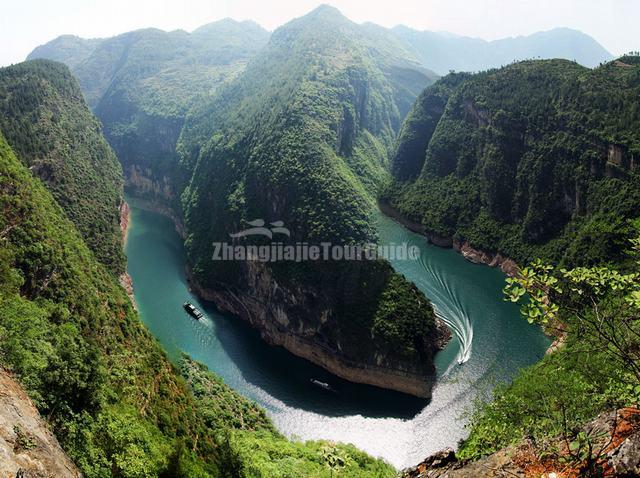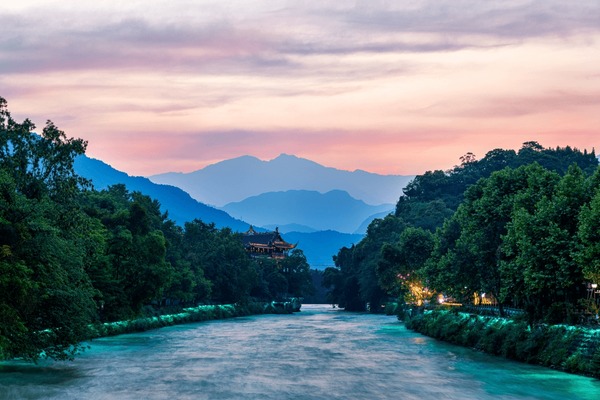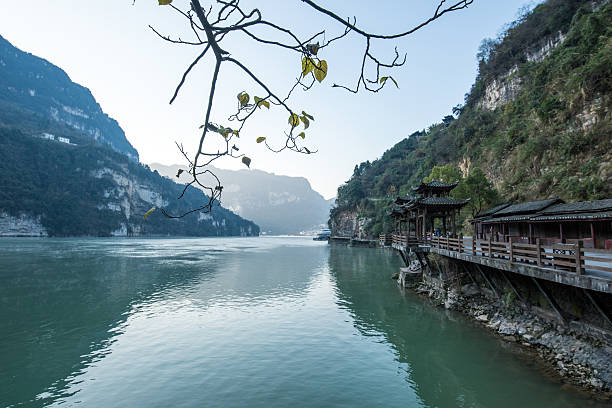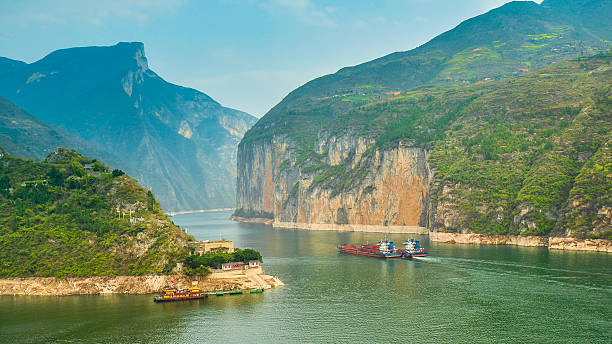Tongjiyan Dam: The Perfect Escape for Nature Lovers and Adventure Seekers

An Essential Guide to Visiting Tongjiyan Dam
Nestled in the lush Bihu Plain of Zhejiang Province, the Tongjiyan Dam stands as a testament to ancient engineering ingenuity and the harmonious relationship between man and nature. Dating back to 505 AD, this remarkable structure is not only the earliest arch dam in the world but also a living piece of history that continues to serve its primary purpose: irrigation. With its impressive 275-meter length and striking 120-degree arch, the dam gracefully spans the Songyinxi River, showcasing a blend of historical significance and stunning natural beauty.
As you wander through the picturesque landscapes surrounding the dam, you’ll be captivated by the intricate canal systems and lush paddies that have flourished thanks to this remarkable irrigation project. The Tongjiyan Dam is more than just a structure; it’s a vibrant part of the local culture, with generations of villagers, including the Zhuge family of weir protectors, dedicated to its upkeep and preservation. This site is not just for history buffs; it’s an oasis for nature lovers, photographers, and anyone looking to immerse themselves in the serene beauty of Jiangnan.
Whether you’re drawn by the dam’s historical significance, its remarkable engineering, or the stunning scenery of the Bihu Plain, a visit to Tongjiyan Dam promises an enriching experience that transcends time. Prepare to soak in the sights, explore the surrounding waterways, and discover the stories etched into the very stones of this ancient marvel.
In This Guide
- An Essential Guide to Visiting Tongjiyan Dam
- The Rich History and Legends of Tongjiyan Dam
- Main Highlights: What You Absolutely Can’t Miss
- Planning Your Visit: A Practical Guide
- Tickets: Prices, Booking, and Tips
- How to Get There: A Complete Transportation Guide
- Local Cuisine and Accommodation Nearby
- Frequently Asked Questions
- Final Thoughts on Your Trip
The Rich History and Legends of Tongjiyan Dam
Nestled in the picturesque Bihu Plain of Zhejiang Province, the Tongjiyan Dam stands as a testament to ancient engineering and rich cultural history. Its origins trace back to 505 AD, during the Southern Dynasty of Liang, marking it as one of the earliest examples of hydraulic engineering in the world. Initially constructed as a wooden arch dam across the Songyinxi River, this remarkable structure has endured the test of time and natural calamities, evolving into a sophisticated irrigation system that has sustained local agriculture for centuries.
The dam’s design is notable for being the earliest arch dam globally, measuring 275 meters in length and featuring a unique low arch structure that showcases the advanced engineering skills of its creators. Throughout the Tang (618-907 AD) and Song (960-1279 AD) dynasties, the dam underwent significant improvements, transforming it into a bamboo irrigation system with intricate networks of canals, gates, and ponds. By the 13th century, the Tongjiyan irrigation system boasted an impressive reach of 2,000 hectares, a feat that speaks to its vital role in irrigation and agriculture.
Despite its robust design, the dam faced challenges, particularly from the floods of the Songyinxi River. Historical accounts detail how the dam was frequently damaged and rebuilt each year, a labor-intensive practice that lasted for nearly seven centuries. It wasn’t until 1205 that a stone masonry dam replaced the original structure, significantly enhancing its durability. This upgrade introduced features such as sand-flushing sluices and ship locks, creating a multifunctional water system that integrated storage, diversion, and shipping capabilities.
One of the most remarkable aspects of the Tongjiyan Dam is its management system, which has persisted for nearly a millennium. From as early as 1092, local governance and community involvement worked in tandem to maintain and allocate water resources effectively. The management regulations, inscribed on stone at the nearby Zhan-Nan Sima temple, detail protocols for water allocation, repair responsibilities, and the roles of various stakeholders in the irrigation system. This collaborative approach to water management has ensured that the Tongjiyan Dam remains functional and continues to meet the agricultural needs of the region.
Legends surrounding the dam also enrich its historical tapestry. The Zhuge family, renowned as the guardians of the weir, have lived in close proximity for generations, diligently protecting the structure against vandalism and ensuring its maintenance. Their dedication is a living embodiment of the community’s reverence for this ancient marvel.
Today, as visitors explore the Tongjiyan Dam, they are not just witnessing a piece of engineering history; they are stepping into a narrative that intertwines human ingenuity with the natural world. The dam’s enduring presence, coupled with its irrigation prowess, continues to nourish the fields and livelihoods of those in the Bihu Plain, a stunning reminder of how ancient traditions and modern life coexist in this vibrant region.

Tongjiyan Dam.
Main Highlights: What You Absolutely Can’t Miss
When exploring the Tongjiyan Dam, an ancient marvel with a history that stretches back to 505 AD, there are several unforgettable highlights that you simply can’t miss. This remarkable irrigation structure, located in the Bihu Plain of Zhejiang Province, is not only a testament to ancient engineering but also plays a crucial role in the region’s agricultural success.
1. The Dam Itself
The Tongjiyan Dam is celebrated as the earliest arch dam in the world. Spanning 275 meters in length, with a base width of 25 meters and a height of 2.5 meters, this architectural feat was originally constructed using timber and later transformed into a stone structure during the Song Dynasty. Standing in front of this ancient dam, you can appreciate the ingenuity of early engineers who devised a robust system capable of withstanding floods and ensuring irrigation for centuries.
2. The Aqueduct and Canal System
Don’t miss the intricate canal aqueduct, completed in 1111. This is the earliest three-dimensional across-flow divided irrigation system in China. The aqueduct showcases an impressive engineering design that illustrates the advanced water management techniques of its time. As you walk along the canals, take in the view of the surrounding landscapes while understanding how this system has sustained irrigation over 1,500 years.
3. Irrigation Heritage
The Tongjiyan irrigation system historically expanded to cover an impressive 2,000 hectares by the 13th century. Today, it still serves as a vital irrigation source, demonstrating the effectiveness of traditional practices in modern agriculture. The sight of the lush, green fields nourished by the canals is a beautiful reminder of the dam’s vital role in the local ecosystem.
4. Cultural Significance
The management of the Tongjiyan irrigation system reflects a remarkable collaboration between the local community and officials. The management regulations, inscribed on a stone near the Zhan-Nan Sima temple, date back to 1092 and emphasize the importance of cooperative governance. Engaging with the local culture and understanding this shared responsibility will enrich your visit.
5. Natural Beauty of Bihu Plain
The dam is set against the backdrop of the picturesque Bihu Plain, characterized by its natural beauty and geographical significance. The region’s topography, with a drop of 20 meters from southwest to northeast, allows for efficient gravity irrigation, making it a scenic spot for photography and exploration.
6. The Zhuge Family Legacy
Take a moment to learn about the Zhuge family, known as the protectors of the weir. Generations of the Zhuge family have lived near the dam, ensuring its preservation and maintenance. Their dedication is a testament to the cultural heritage surrounding the Tongjiyan Dam, making their story an intriguing aspect of your visit.
7. Free Admission and Accessibility
One of the best parts of visiting the Tongjiyan Dam is that admission is free! This openness encourages all visitors to experience this historical site. Located about 25 kilometers from Lishui city, the dam is easily accessible via local transport or by renting a car, making it a perfect day trip for those exploring the region.
8. Culinary Delights Nearby
After exploring the dam, consider indulging in local cuisine. The area is known for its delicious dishes, including Jinyun baked cakes and other local specialties, making for a satisfying conclusion to your visit.
Final Thoughts
A visit to Tongjiyan Dam is more than just a look at an ancient irrigation system; it’s a journey through history, culture, and natural beauty. Whether you’re an engineering enthusiast, a history buff, or simply a lover of beautiful landscapes, this destination promises to leave you with lasting memories.

Tongjiyan Dam.
Planning Your Visit: A Practical Guide
Planning Your Visit to Tongjiyan Dam
Visiting the Tongjiyan Dam offers a unique glimpse into one of the oldest and most significant irrigation structures in China. Nestled in the picturesque Bihu Plain of Zhejiang Province, this historical marvel not only serves as a vital water conservation project but also as a testament to ancient engineering. Here’s everything you need to know for a smooth visit.
Getting There
By Air:
The nearest airport is Wenzhou Longwan International Airport. From the airport, you can take a bus or a high-speed train to Lishui, which is approximately a two-hour journey.
By Train:
Lishui Station is well-connected by high-speed trains from major cities:
– Hangzhou: About 1.5 hours
– Shanghai: Approximately 3 hours from Shanghai Hongqiao Station
By Car:
If you prefer driving, renting a car is a good option. The roads leading to Tongjiyan Dam offer stunning views of the surrounding landscape, but be cautious of winding mountain roads.
Entry Information
- Admission: Free of charge
- Recommended Duration: Plan to spend about 1-2 hours at the dam to fully appreciate its historical significance and the surrounding scenery.
Best Time to Visit
The ideal time to explore Tongjiyan Dam is during the spring (March to May) and autumn (September to November) seasons. Spring blossoms and autumn foliage create a beautiful backdrop for photography and leisurely walks around the area. Avoid visiting during the rainy season when floods may affect accessibility.
What to Expect
- Historical Significance:
-
The Tongjiyan Dam, built in 505 AD, is the earliest arch dam in the world, showcasing ancient engineering prowess. Its construction reflects advanced technology of its time, making it a must-see for history enthusiasts.
-
Scenic Beauty:
-
The dam is located within a tranquil landscape, perfect for nature lovers. The surrounding Bihu Plain is known for its lush greenery, making it an excellent spot for leisurely strolls and picnics.
-
Cultural Insights:
- Engage with local villagers and learn about the history of the dam and its ongoing importance in agriculture. The Zhuge family, known as guardians of the dam, have preserved local customs and can provide fascinating insights.
Nearby Attractions
- Yantou Village: A charming village nearby that offers a glimpse into local life and culture.
- Oujiang River: Ideal for boat rides and enjoying picturesque views of the river and its surroundings.
- Guyang Painting Village: A short drive away, this village is known for its art scene and stunning landscapes, perfect for a creative outing.
Travel Tips
- Wear Comfortable Shoes: Expect to walk around and explore the area, so comfortable footwear is a must.
- Bring a Camera: The dam and its surroundings offer numerous photo opportunities.
- Pack Snacks and Water: While there are local eateries, having some refreshments handy is always a good idea, especially if you’re planning to spend a while exploring.
Cultural Etiquette
Respect local customs and traditions. When interacting with locals, a friendly smile and a simple greeting can go a long way in making your visit enjoyable.
Conclusion
A visit to Tongjiyan Dam not only enriches your understanding of ancient Chinese engineering but also allows you to immerse yourself in the serene beauty of Zhejiang’s countryside. Whether you’re a history buff, nature enthusiast, or simply seeking a peaceful getaway, this site offers a memorable experience. Enjoy your journey through time at Tongjiyan Dam!

Tongjiyan Dam.
Tickets: Prices, Booking, and Tips
Visiting the historic Tongjiyan Dam, the earliest arch dam in the world, is a unique experience that combines rich cultural heritage with stunning engineering marvels. Here’s everything you need to know about tickets, pricing, and some handy tips for your visit.
Admission Information
Ticket Price:
Admission to the Tongjiyan Dam is FREE! This makes it an excellent opportunity for travelers looking to explore significant historical sites without the burden of entry fees.
Booking Details
While no advance booking is required due to the free admission policy, it’s advisable to check local travel advisories or visitor guidelines before your trip. This can ensure you are aware of any potential changes in access or restrictions that may arise.
Best Visiting Times
The ideal time to visit Tongjiyan Dam is during the spring (April) when cherry blossoms frame the scenery, or in the fall (November) when golden ginkgos line the pathways. These seasons not only provide breathtaking landscapes but also a more comfortable climate for exploration.
Tips for Your Visit
-
Transportation: The dam is located approximately 25 kilometers from Lishui city. You can reach it via a scenic drive or by renting a car, which is the most flexible option. Public transportation may be limited, so plan accordingly.
-
Duration: Allocate about 1-2 hours for your visit. This allows ample time to appreciate the dam’s architecture, take photos, and explore the surrounding area.
-
What to Bring: Always have your camera ready! The dam’s picturesque setting offers countless photo opportunities. Don’t forget sun protection, as the area may not have much shade.
-
Local Insights: Engage with the local community, especially the Zhuge family, who are the traditional protectors of the dam. They can provide fascinating insights into the dam’s history and its significance to the local culture.
-
Combine Your Visit: Consider pairing your visit to the dam with a trip to nearby attractions such as the Guyang Painting Village or the stunning Yunhe Terraces, which are known for their breathtaking views and artistic heritage.
With its rich history and stunning architecture, the Tongjiyan Dam is a must-visit destination for any traveler exploring the beautiful landscapes of Zhejiang Province. Enjoy your journey through time!
How to Get There: A Complete Transportation Guide
Getting to Tongjiyan Dam (通济堰) is an adventure that opens the door to one of China’s most significant historical and engineering marvels. Nestled in the picturesque Bihu Plain in Zhejiang Province, this ancient irrigation structure is a testament to centuries of water management and agricultural innovation. Here’s how to make your way to this remarkable site.
By Air
The most convenient way to reach Tongjiyan Dam is by flying into Wenzhou Longwan International Airport (WNZ). This airport is the nearest major airport and offers connections to several cities in China and some international destinations.
Upon arriving at Wenzhou Airport, you have a couple of options to continue your journey:
- Bus: Regular buses connect Wenzhou Airport to Lishui City, which is approximately 2 hours away.
- Train: From the airport, take a taxi or shuttle to Wenzhou South Railway Station (about 30 minutes away). From there, you can catch a high-speed train to Lishui, which takes around 1 hour.
By Train
Lishui Station serves as the main rail hub for travelers heading to Tongjiyan Dam. The station is well-connected by high-speed trains from major cities:
- From Hangzhou: The train journey takes about 1.5 hours.
- From Shanghai: Expect a travel time of approximately 3 hours.
Once you arrive at Lishui Station, you can choose your next steps:
By Bus
From Lishui Station, you can catch a local bus to the Tongjiyan Dam area. Look for buses heading towards Dulian District, which is where the dam is located. The bus ride will take around 30-40 minutes.
By Car
For those who prefer a more flexible option, renting a car is an excellent choice. The drive from Lishui City to Tongjiyan Dam takes about 30 minutes. Here are some tips for driving in the area:
- Navigation: Use a GPS or a navigation app to help you find the best route.
- Road Conditions: Be prepared for winding mountain roads, especially if you venture deeper into the scenic areas.
By Taxi or Ride-Hailing
If public transport isn’t your style, taxis and ride-hailing services like Didi are widely available in Lishui. Simply book a ride to Tongjiyan Dam, and you’ll be there in no time.
Tips for Your Visit
- Best Time to Visit: The ideal months to explore Tongjiyan Dam are from April to November when the weather is pleasant, and the surrounding scenery is at its most vibrant.
- Plan Your Visit: Allocate about 1-2 hours to fully appreciate the dam and its historical significance.
- Free Admission: Entrance to the Tongjiyan Dam is free, making it a budget-friendly excursion.
Conclusion
Whether you arrive by air, train, or road, getting to Tongjiyan Dam is a journey filled with scenic views and rich history. This ancient irrigation marvel not only showcases the ingenuity of early engineering but also offers a serene escape into nature. Make sure to capture your moments at this UNESCO-recognized site, and enjoy your visit to one of China’s hidden gems!

Tongjiyan Dam.
Local Cuisine and Accommodation Nearby
Nestled in the lush landscapes of the Bihu Plain, a visit to the historic Tongjiyan Dam is not just about marveling at its ancient engineering—it’s also a delightful opportunity to indulge in local culinary treasures and cozy accommodations.
Culinary Delights
When it comes to dining near Tongjiyan Dam, the region offers a variety of dishes that reflect the rich agricultural heritage of Zhejiang Province. Here are some must-try local specialties:
-
Jinyun Baked Cakes (金云烤饼): These savory pastries are a local favorite, often filled with pork and preserved vegetables. They are perfectly crispy on the outside and bursting with flavor on the inside. You can find them in street stalls or small eateries around Yantou Village.
-
Suichang Long Zongzi (遂昌长粽子): A unique twist on the traditional zongzi, these long sticky rice dumplings are wrapped in bamboo leaves and filled with a mix of meats and beans. They make for a hearty snack perfect for travelers on the go.
-
Yunhe Stream Fish (云和溪鱼): Freshly caught from the nearby streams, the fish is often grilled or steamed with local herbs and spices. It’s a light yet satisfying meal that pairs wonderfully with rice.
-
Mountain Forest Meals: For a more immersive experience, consider dining at local family-run restaurants offering “Mountain Forest Meals,” where you can enjoy dishes made from seasonal ingredients sourced from the surrounding hills.
Where to Stay
After a day of exploring the dam and enjoying the local flavors, you’ll want a comfortable place to unwind. Here are some charming accommodations near Tongjiyan Dam:
-
Zhu 85 B&B: Located in the picturesque Guyanyan Painting Village, this riverside bed and breakfast offers stunning views of the Ou River. With its artistic decor and friendly atmosphere, it’s a perfect spot for those wanting to soak in the local culture. Rates start at approximately ¥450 per night.
-
Yunhe Seven Star View B&B: Situated near the Yunhe Rice Terraces, this cozy accommodation provides breathtaking views right from your window. The experience of waking up to rolling hills and terraces is simply unforgettable. Prices begin at around ¥500 per night.
-
Tongji Garden Inn: A quaint guesthouse that offers a blend of comfort and authenticity, this inn features traditional Chinese architecture and is conveniently located near the dam. It’s ideal for travelers looking for a homely environment. Rates start at approximately ¥300 per night.
Tips for Your Visit
-
Timing: The best time to visit Tongjiyan Dam is during the spring and autumn months when the weather is mild and picturesque. This period is also great for tasting seasonal local dishes.
-
Local Markets: Be sure to explore local markets for fresh produce and snacks. Vendors often sell homemade items that you won’t find in restaurants.
-
Cultural Experience: Engage with locals and learn about their farming practices and culinary traditions for a richer travel experience.
Whether you’re admiring the dam’s historical significance or savoring the local cuisine, Tongjiyan Dam promises a fulfilling adventure that combines history, nature, and gastronomy.

Tongjiyan Dam.
Frequently Asked Questions
Frequently Asked Questions About Tongjiyan Dam
1. What is the historical significance of Tongjiyan Dam?
Tongjiyan Dam, built in 505 AD, is recognized as the earliest arch dam in the world. It has a rich history of irrigation innovation and was crucial for agricultural development in the Bihu Plains of Zhejiang Province. The dam has served multiple purposes, including water storage, irrigation, and flood control, and its construction techniques were among the most advanced of its time.
2. How can I get to Tongjiyan Dam?
The dam is located near Yantou Village in the Bihu Plain, approximately 25 kilometers from Lishui City. Travelers can reach Lishui by high-speed train, with services available from major cities like Hangzhou and Shanghai. Once in Lishui, you can rent a car or take a local bus to reach the dam.
3. Is there an entry fee to visit the dam?
Visiting Tongjiyan Dam is free of charge, making it an accessible destination for all travelers. While there are no ticket costs, you may want to budget for nearby transportation or guided tours.
4. What are the best times to visit?
The best times to visit Tongjiyan Dam are during the spring (April) for cherry blossoms and the fall (November) for golden ginkgo trees. These seasons offer stunning natural beauty, perfect for photography and leisurely walks around the area.
5. How long should I plan to spend at Tongjiyan Dam?
A visit to Tongjiyan Dam typically takes about 1-2 hours. This allows enough time to explore the dam, enjoy the scenic views, and appreciate the historical significance of the site. For a more immersive experience, consider combining your visit with nearby attractions such as the Guyang Painting Village.
6. Are there any local guides available?
Yes, local guides are often available for hire, offering insights into the dam’s history and its importance in the region. Engaging a guide can enhance your experience by providing context and answering any questions you may have.
7. What amenities are available near the dam?
While the dam itself is primarily a historical and irrigation site, there are several local villages nearby where you can find basic amenities, including food options and restrooms. It’s advisable to bring water and snacks, especially if you plan to explore the surrounding area.
8. Can I take photos at Tongjiyan Dam?
Absolutely! Photography is encouraged at Tongjiyan Dam. The dam’s stunning architecture, the scenic landscape of the Bihu Plain, and the historical features provide excellent opportunities for memorable photos. Just be respectful of the site and other visitors while capturing its beauty.
Final Thoughts on Your Trip
As your journey to Tongjiyan Dam comes to a close, take a moment to reflect on the incredible blend of history, culture, and nature that this ancient marvel offers. Standing as the world’s earliest arch dam, Tongjiyan is not just a testament to the ingenuity of ancient engineers but also a living monument that continues to sustain the lush landscapes of the Bihu Plain.
Wandering through the serene waterways and lush fields, you’ll feel a profound connection to the generations that have relied on this irrigation system for their livelihoods. The harmonious coexistence of nature and human ingenuity here is a reminder of the importance of preserving our historical treasures.
Whether you’re an avid history buff, a lover of architecture, or simply seeking a peaceful escape, Tongjiyan Dam promises a unique experience that resonates long after you leave. So, as you head back to the bustling world beyond, carry with you the tranquil spirit of this remarkable site and the stories it has whispered through the ages. Until next time, may your travels continue to inspire and enlighten!